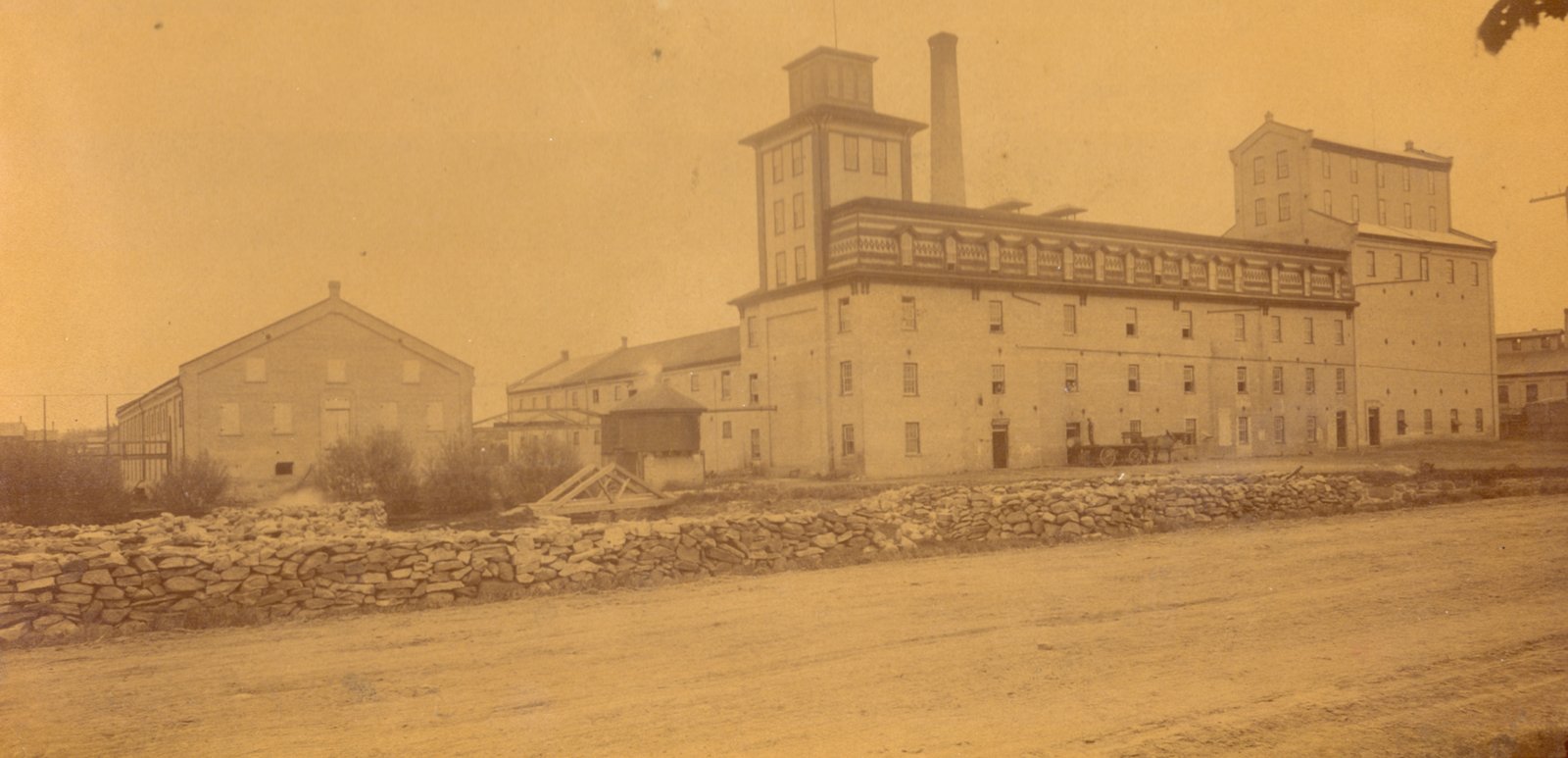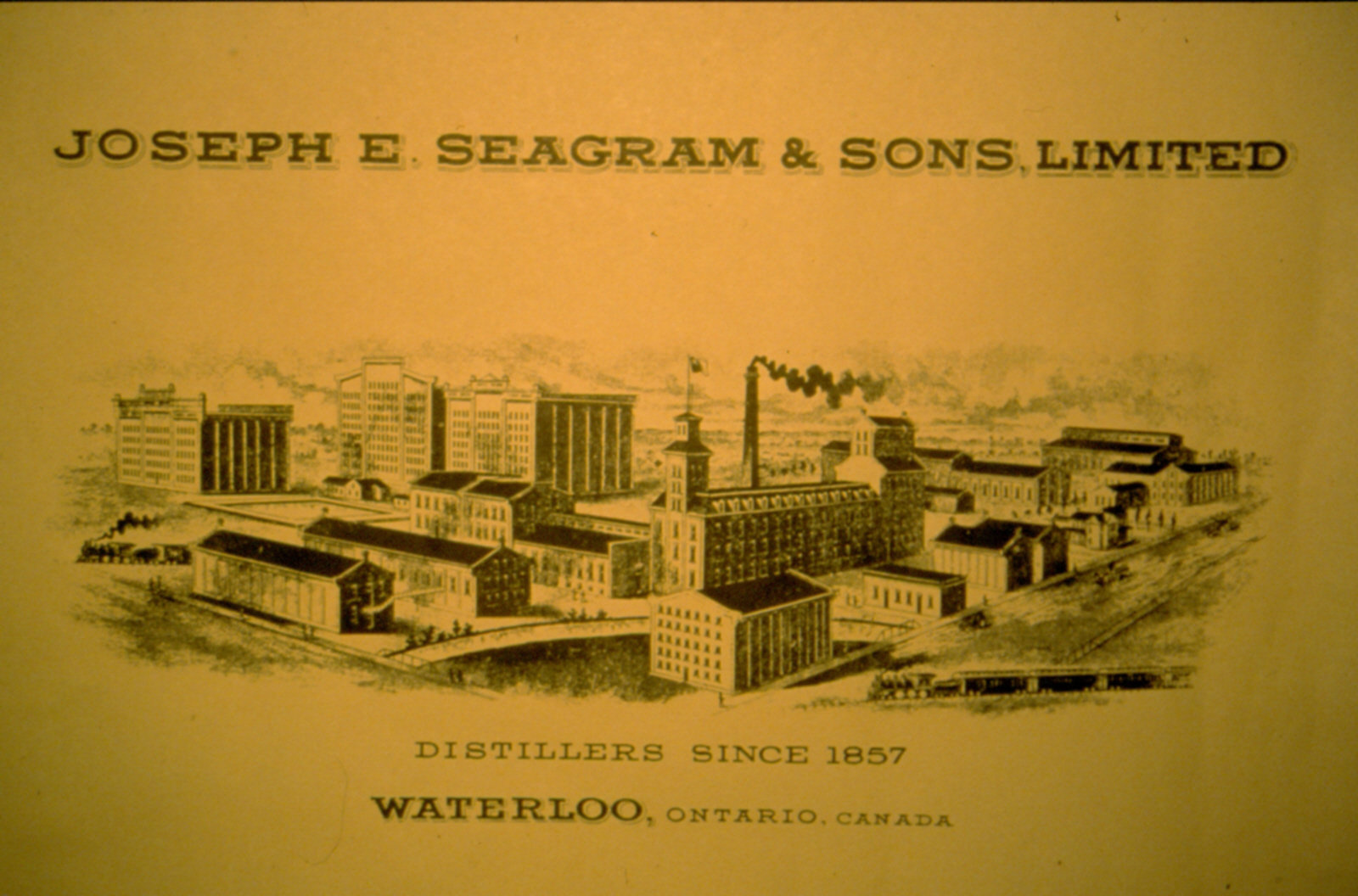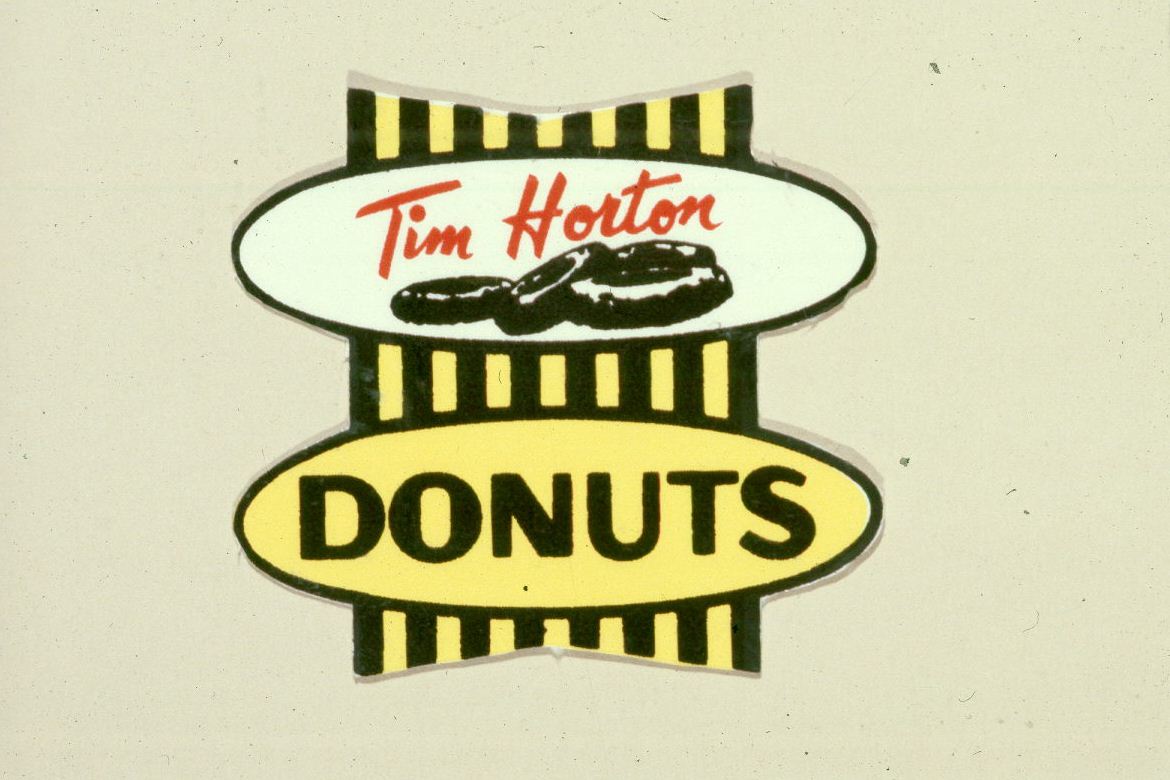
History of Seagram
In 1857, William Hespeler, a merchant from Berlin (now Kitchener) and George Randall, a contractor for the Grand Trunk Railway, established the Granite Mills and Waterloo Distillery, in Waterloo, Canada West (now Ontario). The original plant included a grain mill and dry goods store. Whatever grain remained after milling was mashed and distilled as whisky in what began as a side venture. By 1861, the mill was producing 12,000 barrels of flour and the distillery about 2,700 barrels of whisky. Hespeler and Randall used rye for their liquor and, marketing their product to the area’s German community, called their spirit Alte Kornschnapps (old rye). In 1863, William Roos joined the company as partner.

In 1864, Joseph Emm Seagram, a bookkeeper and manager in the local milling industry, was hired to supervise Hespeler’s interest in the company. By this time, the distilling side of the business had increased production to 50,000 gallons of proof spirits per year. Seagram bought Hespeler’s share of the company in 1868, followed by Randall’s in 1878. By 1875, the company was shipping spirits to Great Britain, Illinois, New York, Michigan and Ohio. Finally, in 1883, Seagram bought out Roos and renamed the business Joseph Seagram Flour Mill and Distillery Company. Four years later, he released Seagram’s 83, celebrating the year he took control of the company.

Seagram concentrated affairs on the distillation and export of spirits and changed the name of Alte Kornschnapps to Seagram’s Old Rye in order to reach a broader range of consumers. In 1911, he changed the company name to Joseph E. Seagram and Sons Ltd. to reflect the inclusion of his sons Edward and Thomas in the business. After their father died in 1919, Edward and Thomas took over the company.

Bronfman Family and the Prohibition Era
The Bronfman family arrived in Canada in 1889 after fleeing the anti-Semitic pogroms of czarist Russia. In 1903, they borrowed money to buy the Anglo-American Hotel in Emerson, Manitoba. Business boomed, and by the middle of the First World War, the family owned three hotels in Winnipeg.
When prohibition was enacted in many provinces during the First World War, the laws varied by province. But in general, prohibition laws closed legal drinking establishments and forbade the sale of alcohol as a beverage. Possession and consumption of alcohol, except in a private dwelling, was also forbidden. (In some provinces, domestically produced wines were exempt.) Still, alcohol could be purchased for industrial, scientific, mechanical, artistic, sacramental and medicinal uses, and distillers, brewers and licensed producers could sell their product outside of their province.
DID YOU KNOW?
In Yiddish, the language of many Eastern European Jews, Bronfman means “brandy man.” The Bronfmans were originally tobacco farmers from Bessarabia (part of modern-day Moldova and Ukraine). The family was not involved in the liquor business until about 1916.
With such imprecise laws, the Bronfmans saw opportunities for profit. The family left the hotel business to go into liquor retailing, purchasing the Bonaventure Liquor Store Company near Montréal’s downtown railway station in 1916. Prohibition was not enacted in Québec until 1919 (and then only briefly), meaning that train travellers could stock up on liquor before trips to the “dry” provinces out West.
Distillers Corporation Limited
In 1924, Samuel Bronfman opened a distillery in LaSalle, Québec, and incorporated under the name Distillers Corporation Limited. In 1927, the company sold a 50 per cent interest to Distillers Company, which controlled more than half the world’s Scotch whisky market. In return, Distillers Corporation received distribution rights for blended whisky brands Haig, Black & White, Dewar’s and Vat 69.
About the same time, Joseph E. Seagram and Sons Ltd. went public. In 1928, the Distillers Corporation acquired all stock in the Seagram business and became a public company, Distillers Corporation-Seagrams Ltd. The company grew through the American prohibition era (1920–33) by exporting alcohol to the United States, where prohibition laws were stricter than in Canada. Under Canadian law, it was legal to sell to American buyers, and the government collected taxes on those sales. However, in 1930, it became illegal to export alcohol to countries under prohibition. As a result, Canadian liquor companies, including Seagram, exported alcohol to Saint-Pierre and Miquelon, a self-governing French territory off the coast of Newfoundland. The alcohol was stored on the French islands and then illegally shipped to the US by smugglers. During this period, Seagram’s profits were down, as it had become increasingly dangerous to transport alcohol to the United States and the Great Depression was affecting sales.
American prohibition ended in 1933, and in 1934 an RCMP investigation into liquor smuggling resulted in the arrest of Abraham, Harry, Allan and Samuel Bronfman. The case revolved around the alleged smuggling of Seagram spirits from Saint-Pierre and Miquelon back into Canada, which would have been a means to dodge liquor taxes. The case was dismissed the following year.
After American Prohibition
Samuel Bronfman had anticipated the end of American prohibition and stockpiled whisky. By 1933, Seagram held the largest private stock of aged whisky, which allowed the company to expand and monopolize the business. A shrewd marketer, Bronfman worked to change the face of whisky drinking in post-prohibition North America, swapping images of bootlegging and speakeasies with notions of refinement and sophistication. In this vein, Seagram’s launched an advertising campaign in 1934 that read: “We who make whiskey say: drink moderately.”
During this period, blending and aging whisky became Seagram’s hallmark. Meanwhile, the Bronfmans revolutionized liquor marketing by selling Seagram products in bottles. The tradition of selling whisky in the bottle was Scottish, and one that allowed the distiller to maintain control over the quality of their product. At the time, most American distillers issued their whiskies in barrel consignments they sent to local “rectifiers,” who would often alter the spirit by adding juices and caramel or by blending it with other whiskies. Bottling the whisky was a way to build brand loyalty through consistent output, a practice that became the industry standard.
“Look, when a man goes into a store for a bottle of Coca-Cola, he expects it to be the same today as it will be tomorrow,” said Samuel Bronfman. “The great products don't change. Well, goddammit, our product’s not going to change either.”
At the end of 1936, Seagram sales reached $60 million in the US market and $10 million in Canada.
In 1939, Seagram introduced Crown Royal in honour of George VI and Queen Elizabeth’s royal tour of Canada that year. The bottle was presented in a purple pouch with gold stitching — which became synonymous with the brand.
Expansion and Diversification
Seagram expanded at a rapid rate, buying other distilleries at a quick pace and branching into winemaking. In 1941, Seagram purchased Browne Vintners, which partly owned Barton & Guestier. During the Second World War, Seagram imported rum from Puerto Rico and Jamaica, which led to the purchase of distilleries in the Caribbean that produced Captain Morgan, Myers’s, Wood’s and Trelawny rums. By 1948, total Seagram sales exceeded $438 million, and the company’s profit was $53.7 million. The following year, Seagram purchased the Chivas distillery in Aberdeen, Scotland, makers of Chivas Regal Scotch whisky.
In the 1950s, Samuel Bronfman brought Seagram in a dramatically different direction when he invested in Royalite, an Alberta oil company. In 1963, Seagram acquired the Texas Pacific Coal and Oil Company for about $276 million, merging it with the Frankfort Oil Company, purchased earlier, to form the Texas Pacific Oil Company Inc. The 1963 purchase of Texas Pacific was considered a major feat, one that Raoul Engel, a reporter with the Financial Post, called “the next best thing to self-levitation, or lifting yourself off the ground by your own shoelaces.” Essentially, Seagram’s acquired Texas Pacific with very little cash — about $50 million. The remaining amount was borrowed on the strength of the purchase asset’s cash flow — oil sales — which would be used to pay the debt.
As Seagram expanded into oil and coal, Edgar Bronfman also expanded the company’s lines of rum, Scotch and bottled cocktails and began importing wine on a large scale. Through the 1960s, blended whisky dropped considerably in the hard liquor market, but Seagram’s high-end products (Seven Crown, Crown Royal, Chivas Regal, Seagram’s V.O.) maintained their growth. At the end of 1965, the company had operations in 119 countries and sales exceeding $1 billion.
In 1971, Edgar Bronfman took over the company, following the death of Samuel Bronfman. In 1975, the company name was changed to The Seagram Company Ltd. and earnings dropped to $74 million. Edgar reorganized the company’s executive and put his brother, Charles Bronfman, at the head of the new executive committee. In 1977, Seagram recorded a net profit of about $84 million and sales were $2.2 billion.
In 1980, Seagram sold Texas Pacific to Sun Oil Company for $2.3 billion. Seeking to invest its earnings, Seagram began to buy shares in American oil company Conoco. At the same time, E.I. du Pont de Nemours and Company (DuPont), a major petrochemicals company, was also making a bid for Conoco. In the end, DuPont acquired Conoco in a $7.8-billion cash and stock deal. After that transaction, Seagram was able to trade in its Conoco shares for 25 per cent of DuPont shares, making Seagram the largest DuPont shareholder (See also DuPont Canada).

In 1988, Seagram acquired Tropicana, the fruit juice and beverage maker, which it sold in 1998 to PepsiCo. In 1989, Edgar Bronfman named his son Edgar Jr. president and COO at Seagram. Declining sales and increased taxation led Seagram to shutter its Waterloo distillery in 1992, which had been in operation for more than 130 years. Two years later, Seagram acquired distribution rights to Absolut vodka, a move many saw as a last-minute concession, since Seagram had long neglected the vodka market (neither Samuel nor Edgar Bronfman understood the appeal of a “tasteless” spirit). Vodka had grown in popularity in North America, while sales in blended whiskies continued to drop during the 1970s and 1980s. At the time of Seagram’s acquisition, Absolut accounted for 60 per cent of the imported vodka market in the United States.

MCA
Edgar Bronfman Jr. took Seagram into the entertainment industry in 1993 by purchasing 15 per cent of US media giant Time Warner. However, Seagram's bid was considered hostile by Time Warner, which did not have a controlling group of shareholders at the time. Seagram sold its shares between 1997 and 1998.
On 6 April 1995, Seagram announced it was selling its stake in DuPont for nearly US$8.8 billion (see also Bronfman Sells DuPont). Three days later, Seagram announced that it was buying MCA Inc. Seagram became a major company in the entertainment field with its 80 per cent ownership of MCA Inc., valued at US$5.7 billion. The sale included Universal Pictures film studios, MCA Television Group, Putnam Berkley Group publishing (which Seagram sold for $330 million in 1996), MCA Music Entertainment Group (later known as Universal Music Group), Universal theme parks, and Spencer Gifts, a chain of gift shops (see Seagrams Buys MCA).
In 1998, Seagram acquired the PolyGram N.V. music company for over US$10.3 billion.
Sale to Vivendi
In 2000, Edgar Bronfman Jr. announced that Seagram would merge with the French conglomerate Vivendi (a water and sewage company that had expanded into entertainment and communications) and CANAL+ in a shares exchange for which Vivendi paid $42 billion for Seagram (see Seagram-Vivendi Deal). The Bronfmans retained about 25 per cent of Seagram in the merged company — translating to 8.6 per cent of Vivendi Universal. The company was headed by Vivendi CEO Jean-Marie Messier. Meanwhile, Vivendi Universal sold Seagram’s liquor properties to Pernod Ricard and Diageo for US$8.15 billion.
The Vivendi operation proved to be unstable and the newly merged company began bleeding money within days. Messier began buying more companies over the objections of the Bronfmans. By 2002, Messier had been dismissed, and Vivendi Universal share values had dropped from $77 per share to less than $25. In 2003, Vivendi auctioned the Seagram art collection to pay its debts. Throughout this time, the Bronfman family divested from the company.
(See also Distilling Industry.)

 Share on Facebook
Share on Facebook Share on X
Share on X Share by Email
Share by Email Share on Google Classroom
Share on Google Classroom


